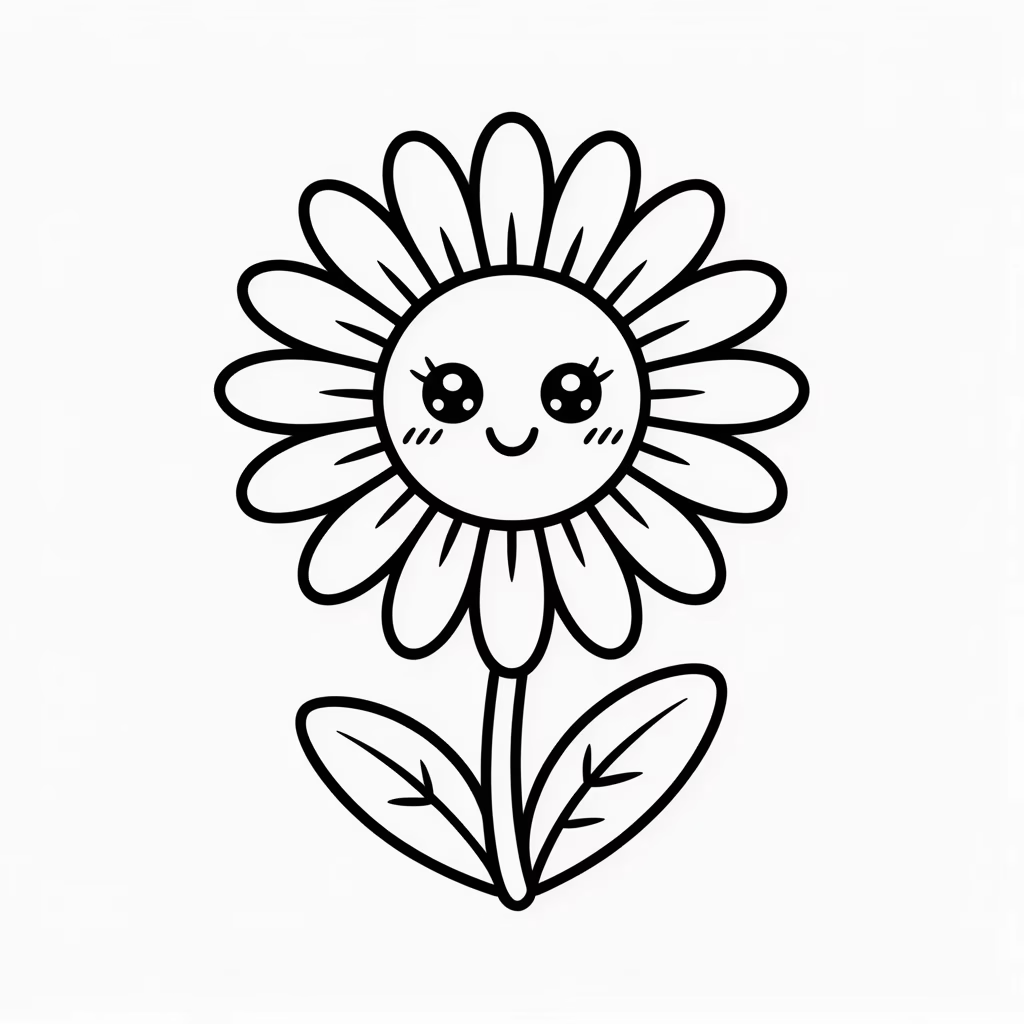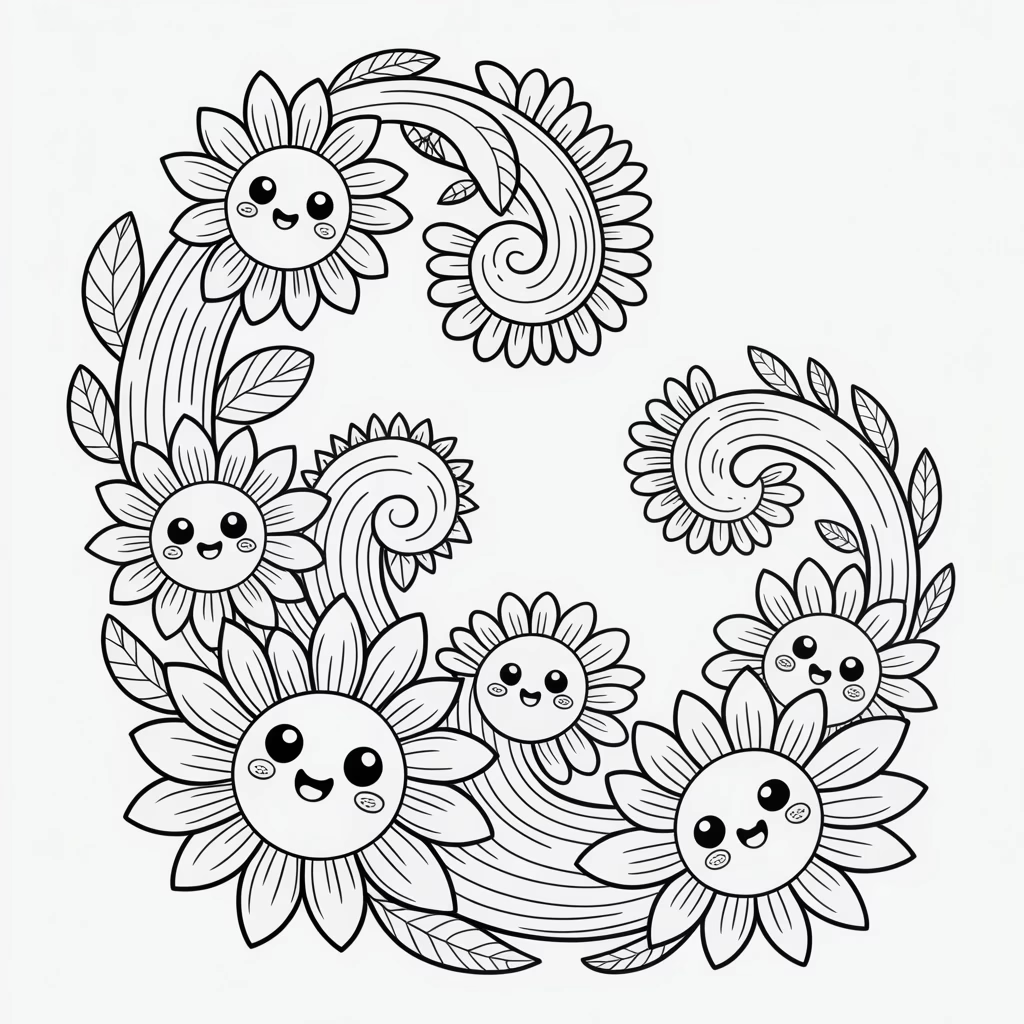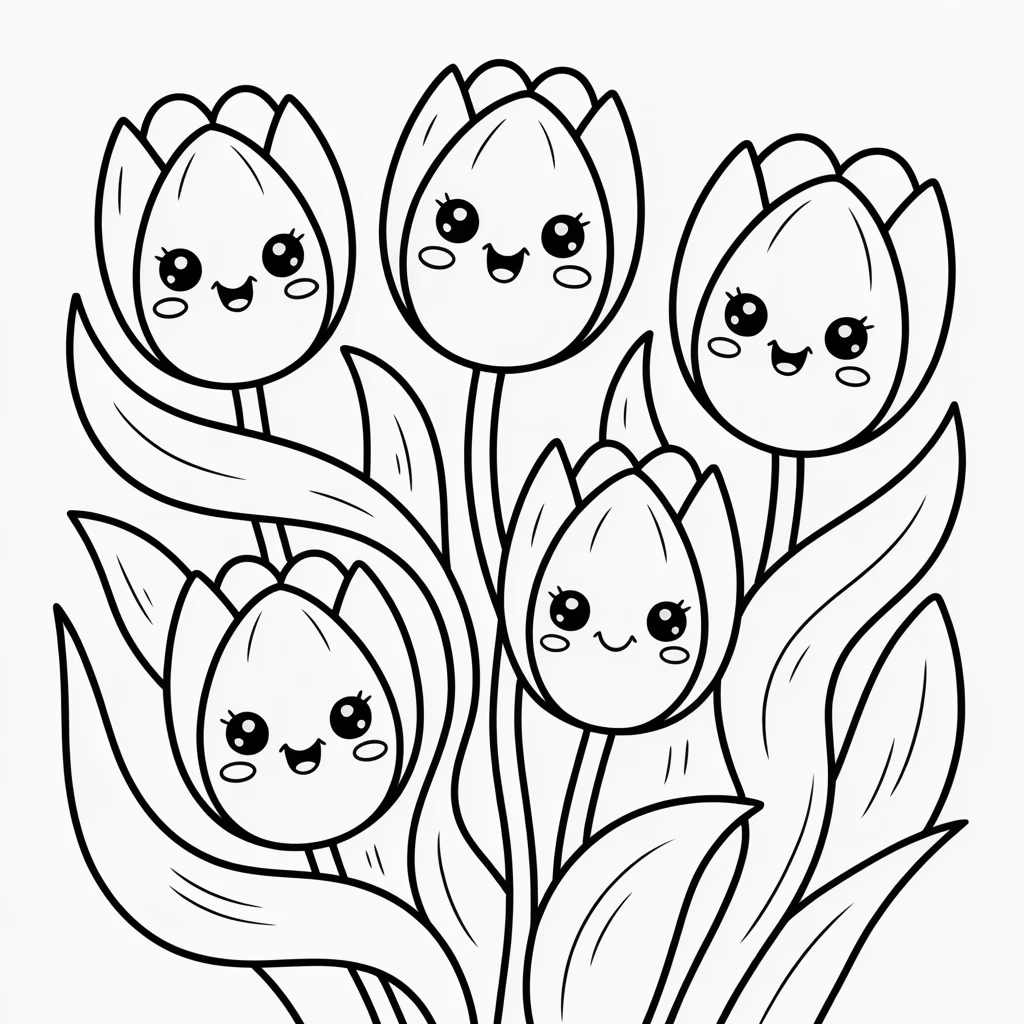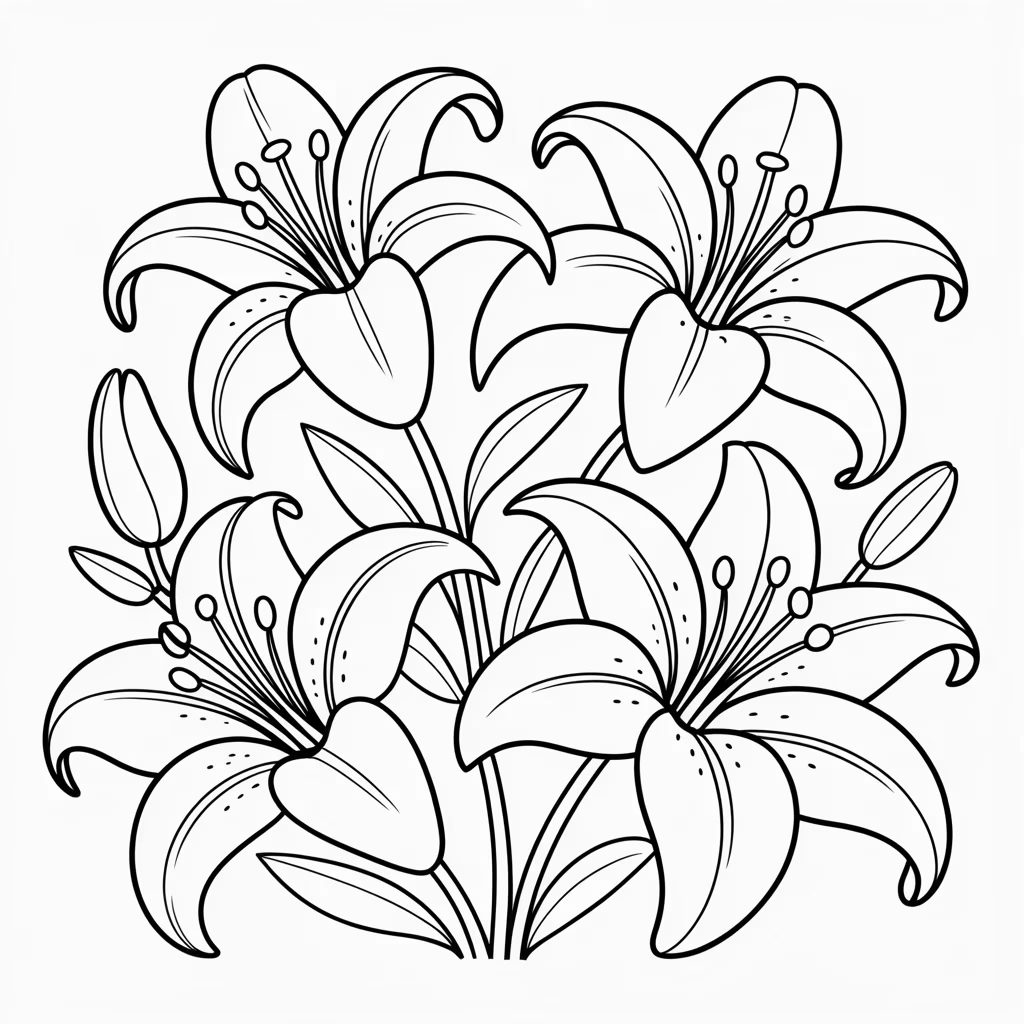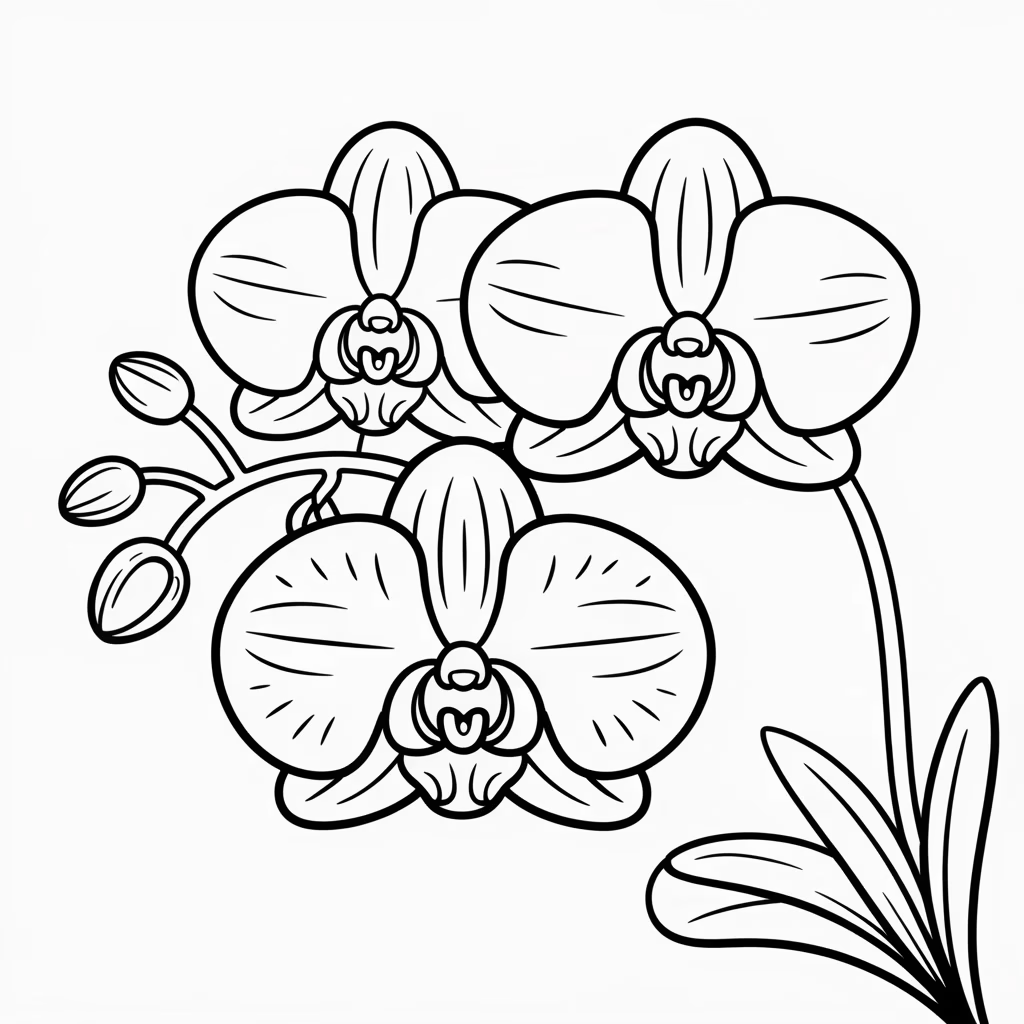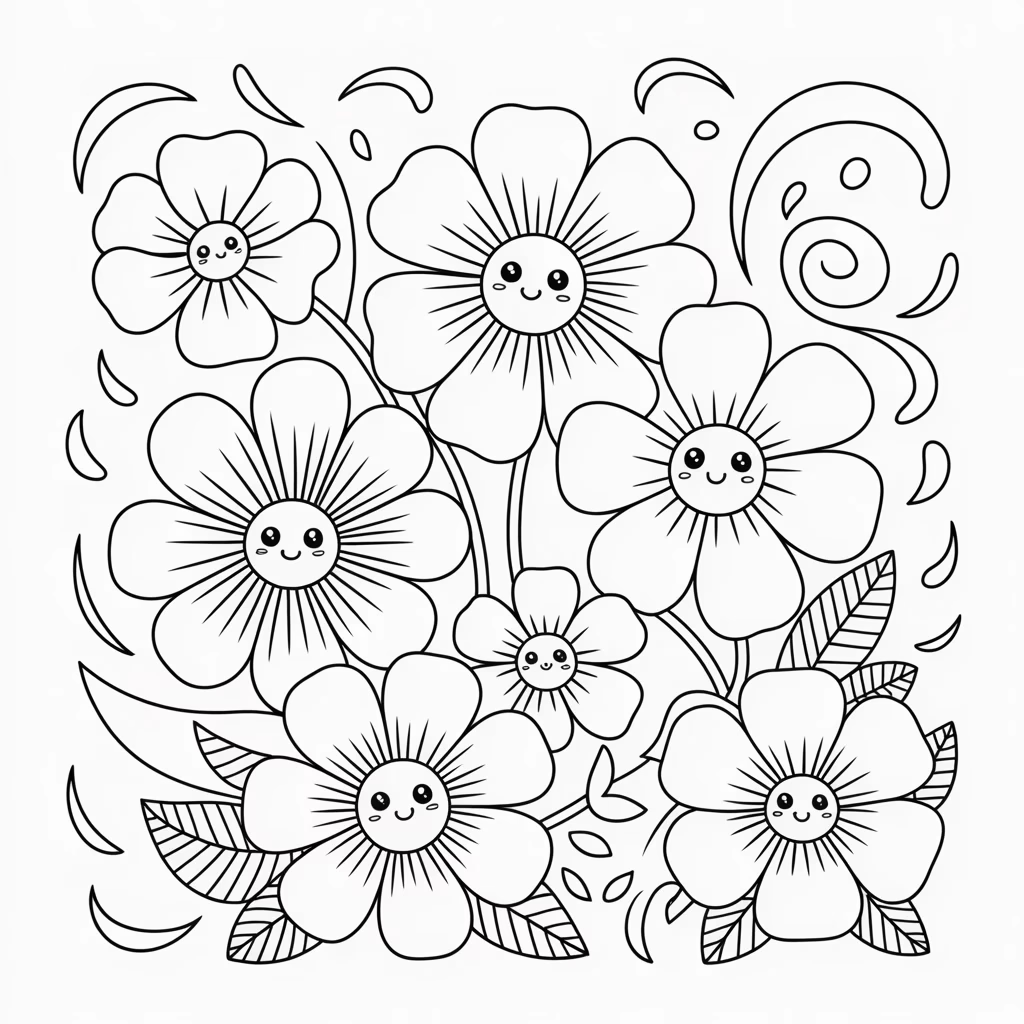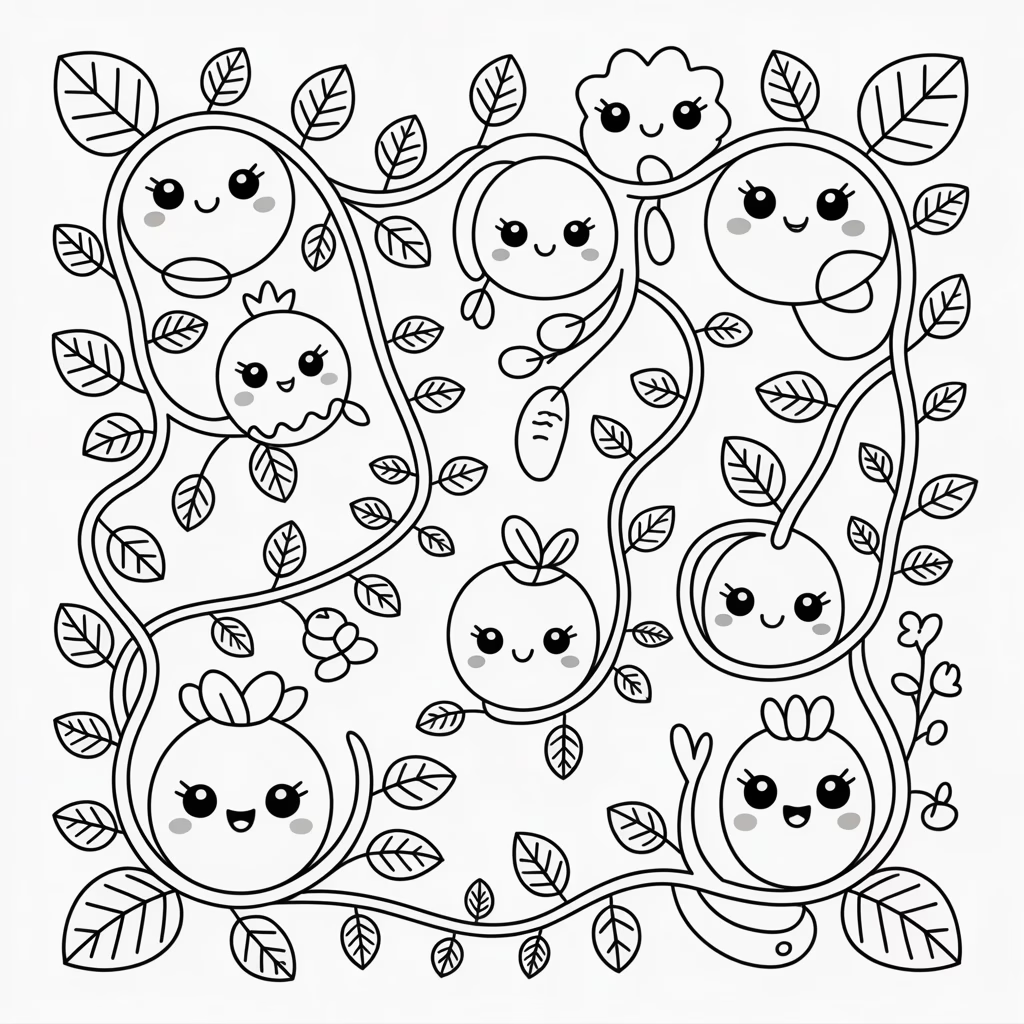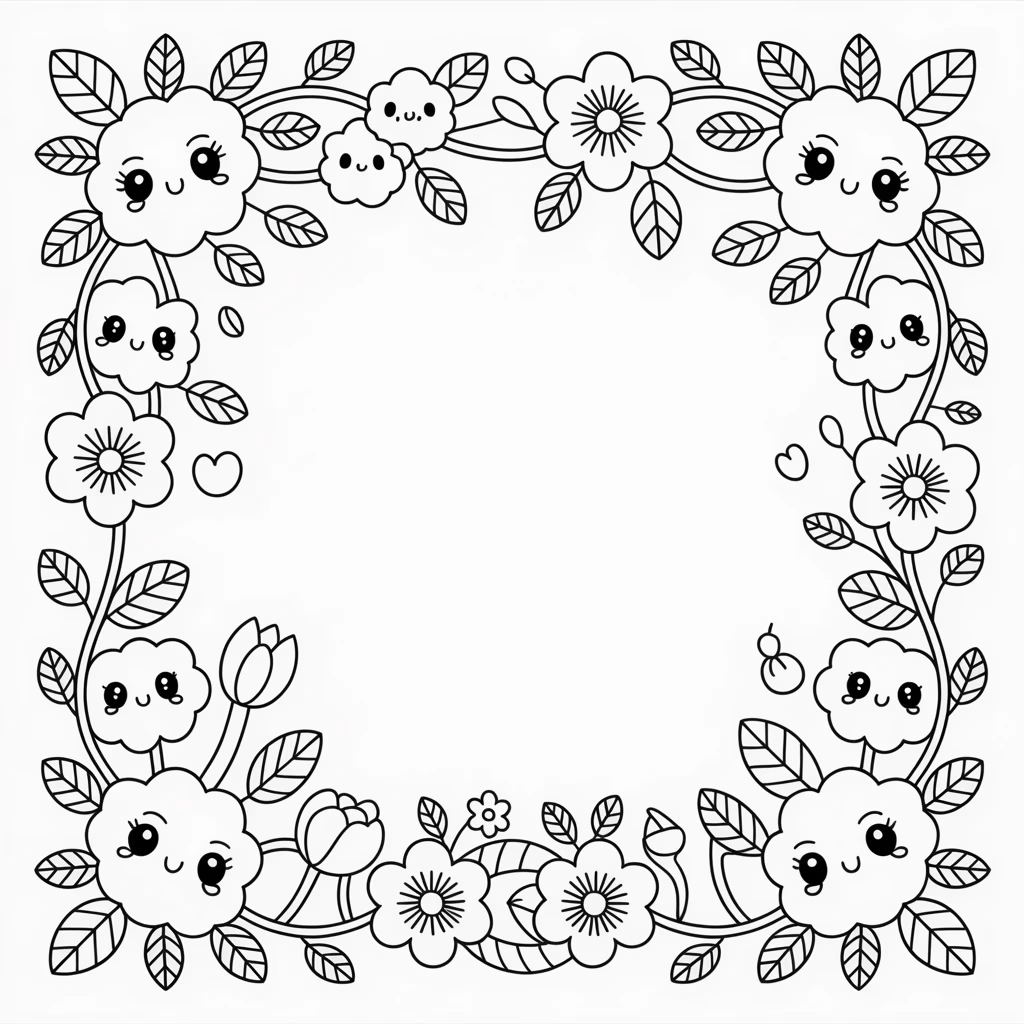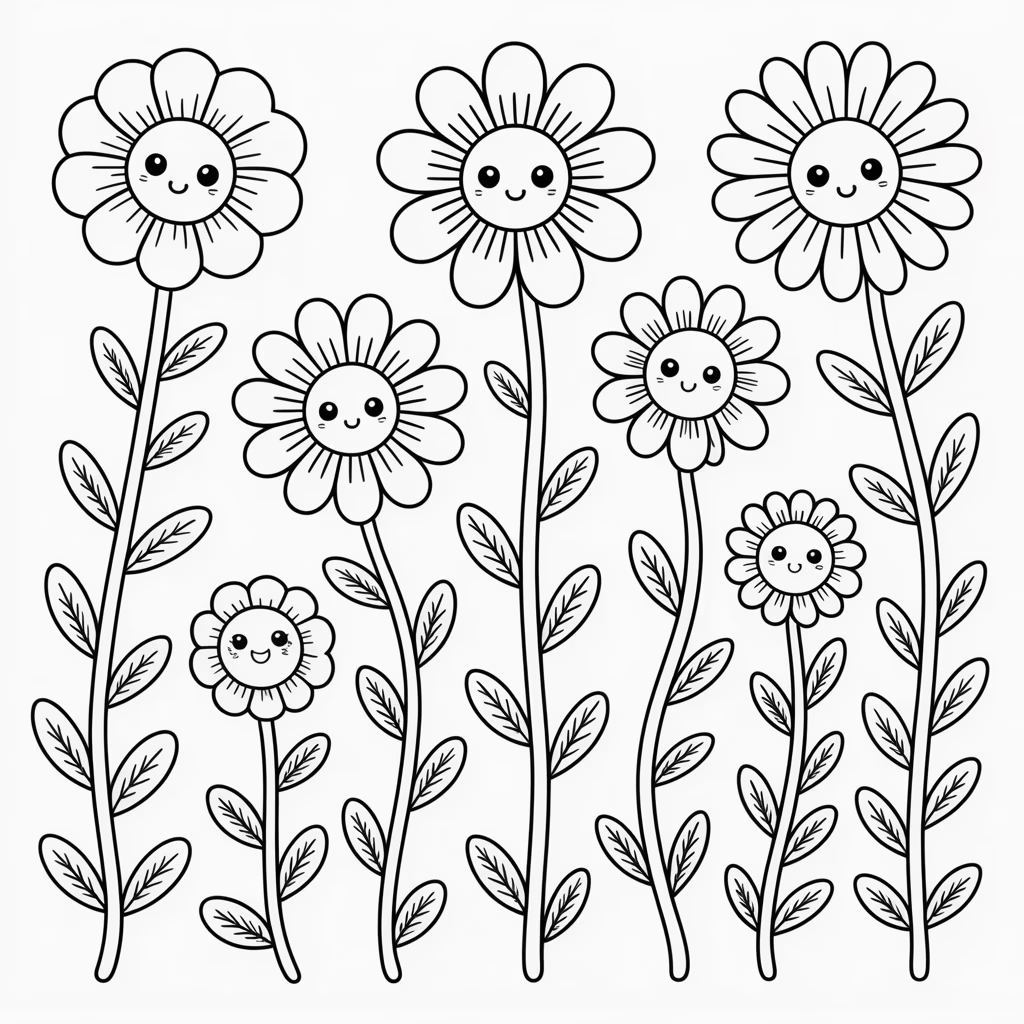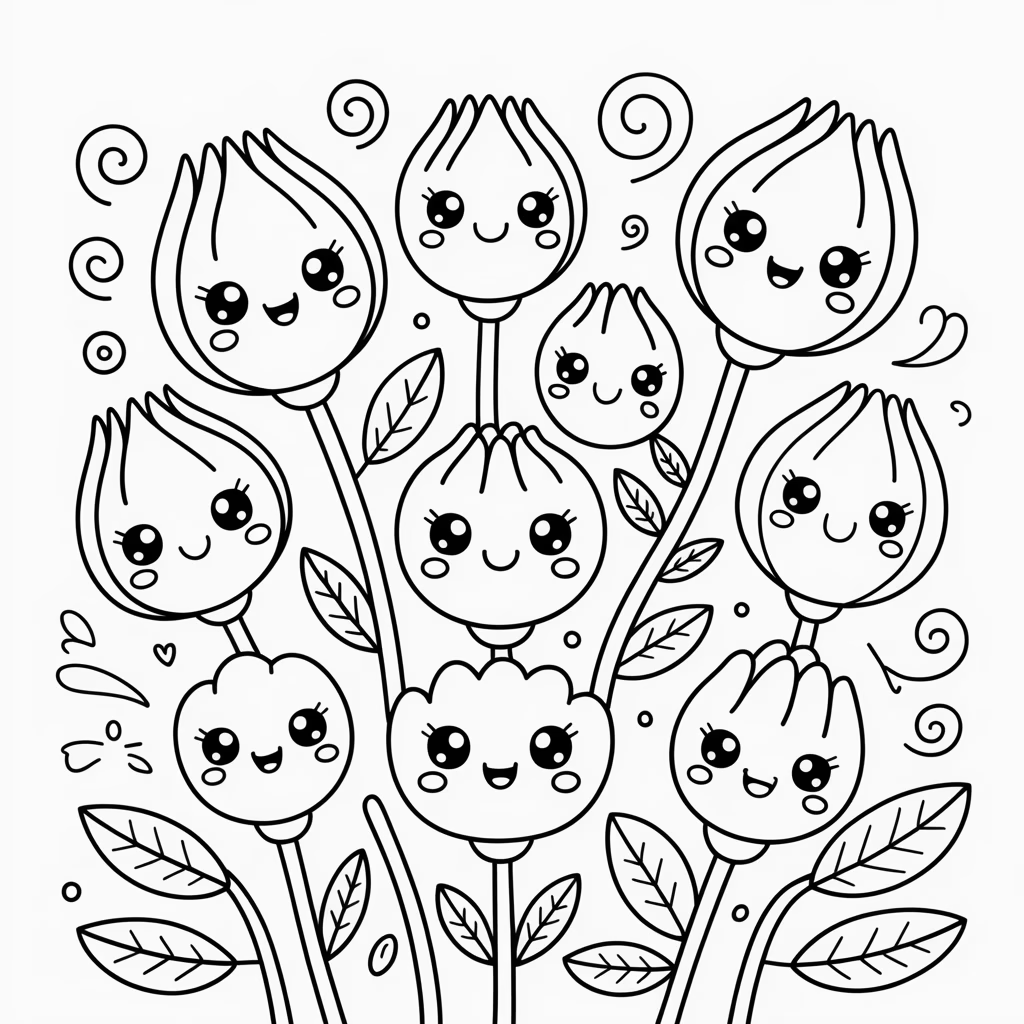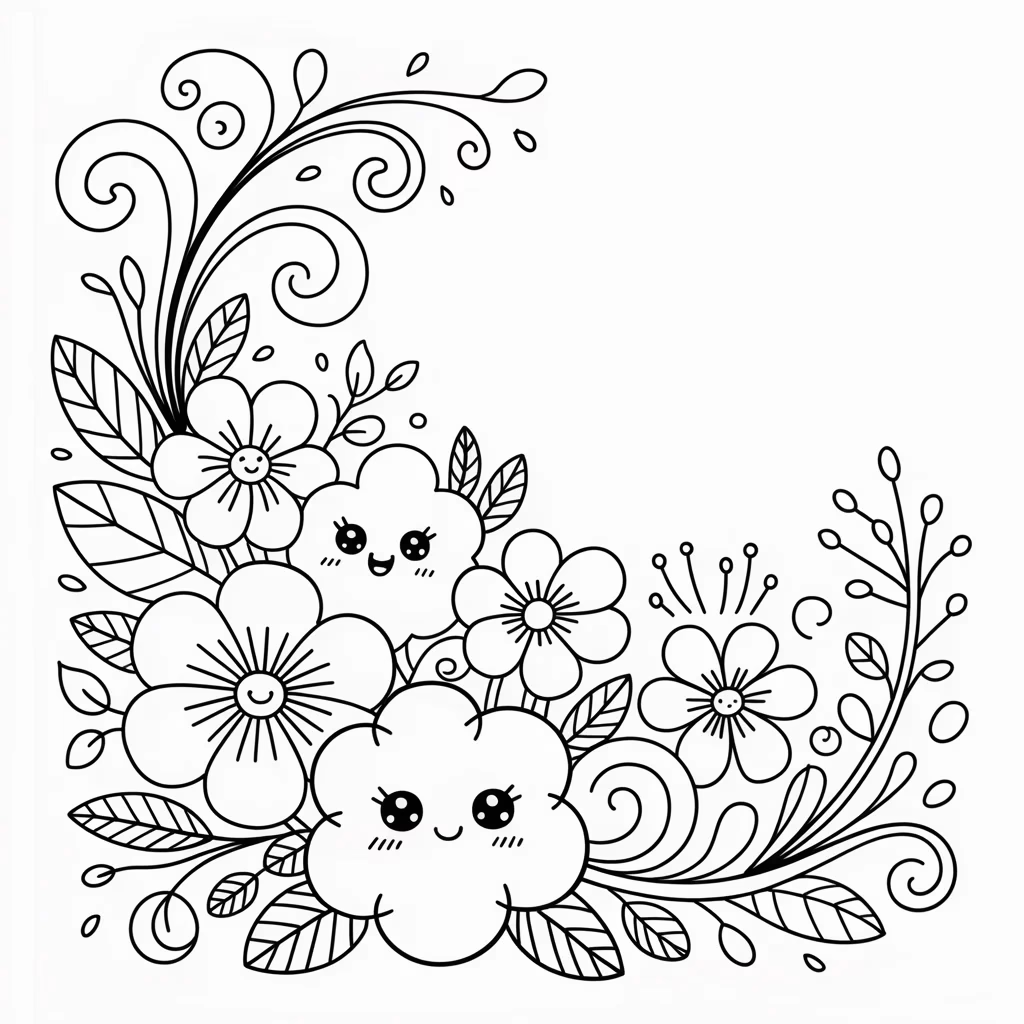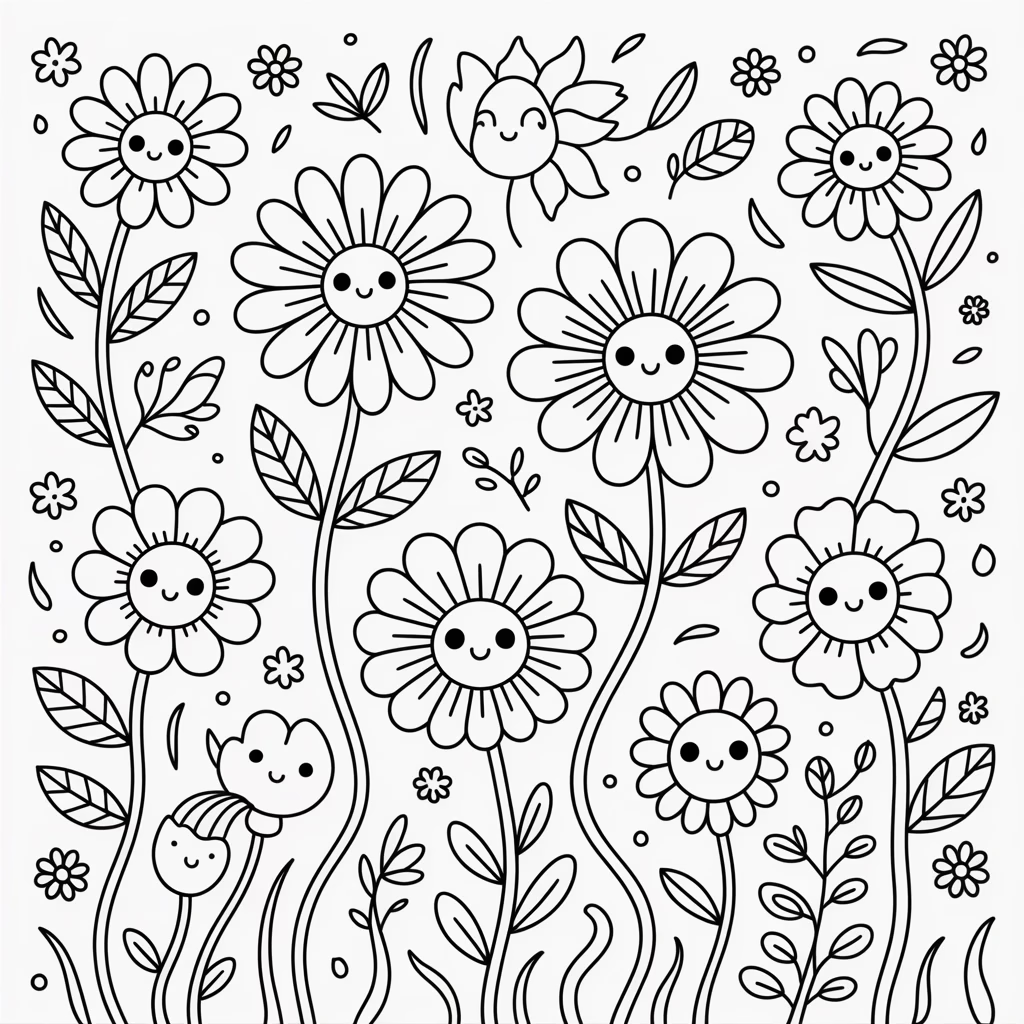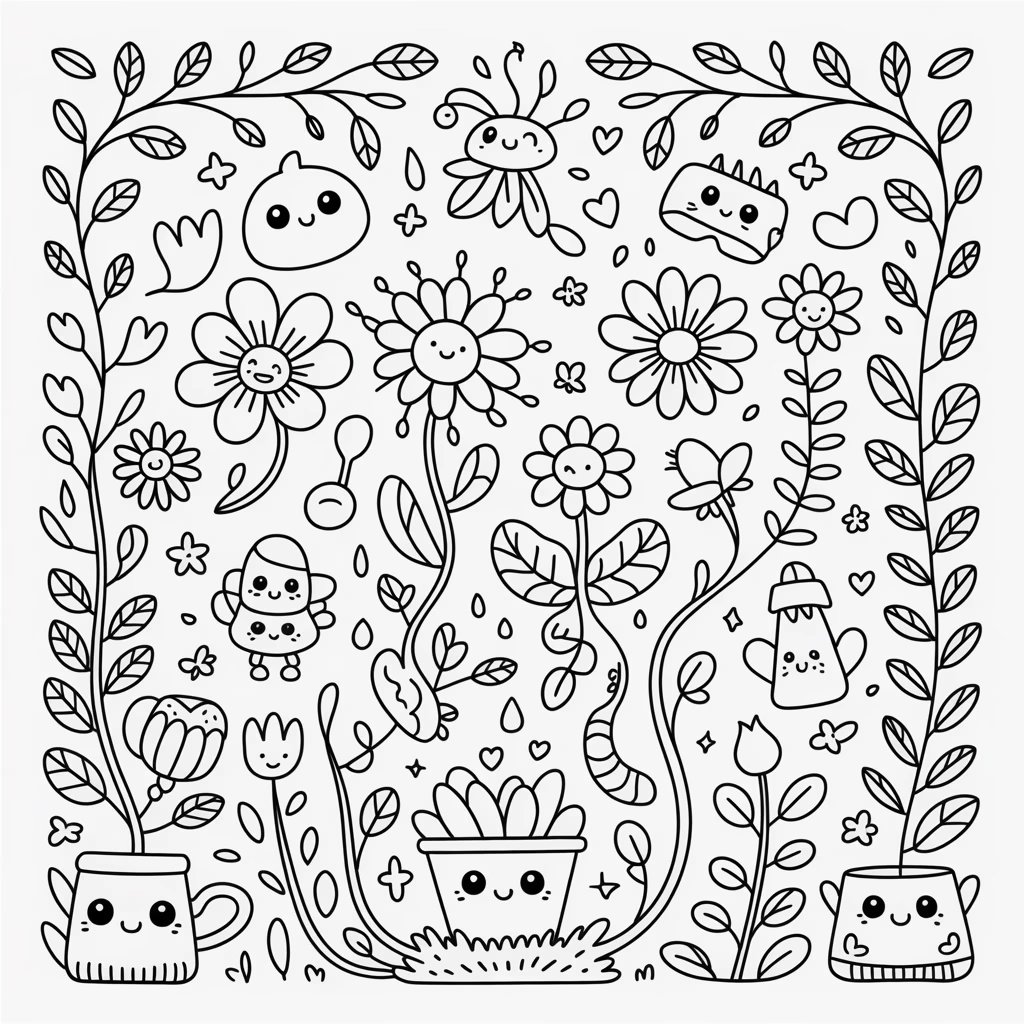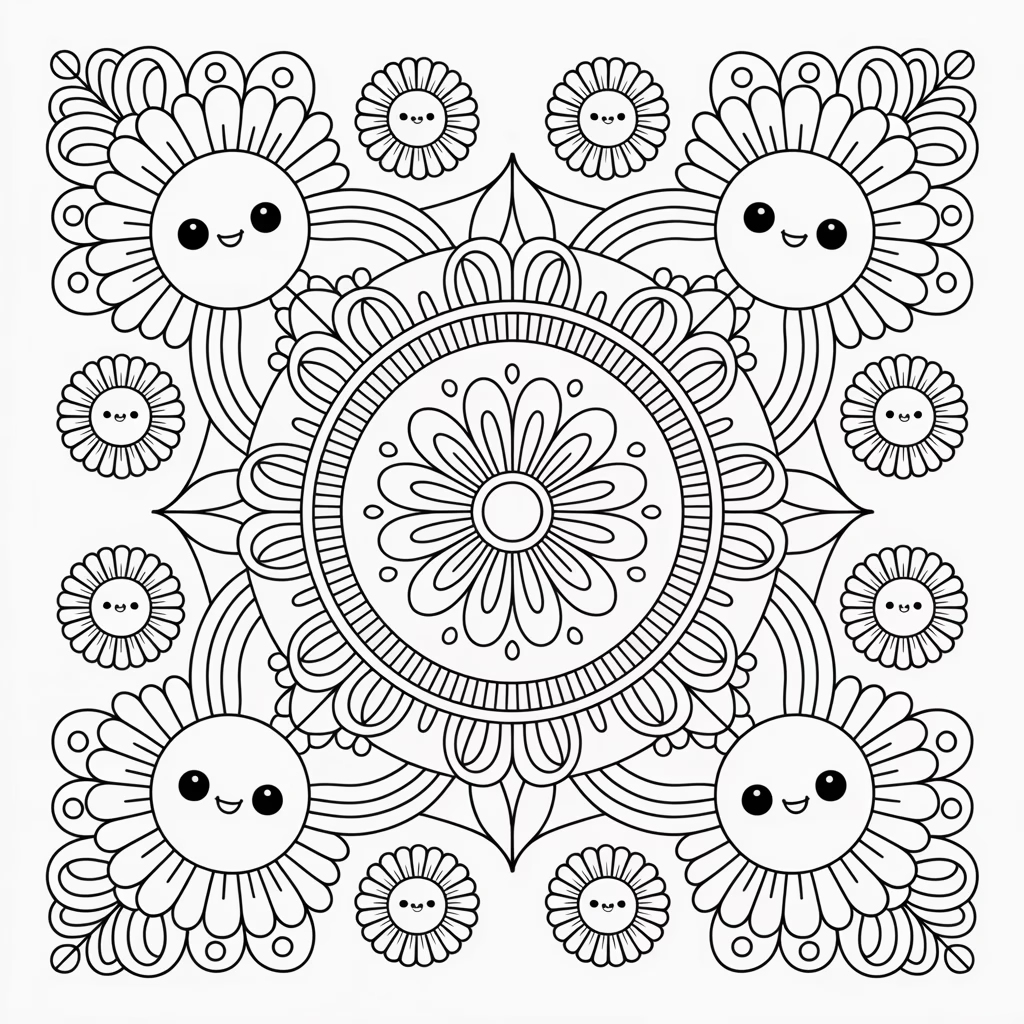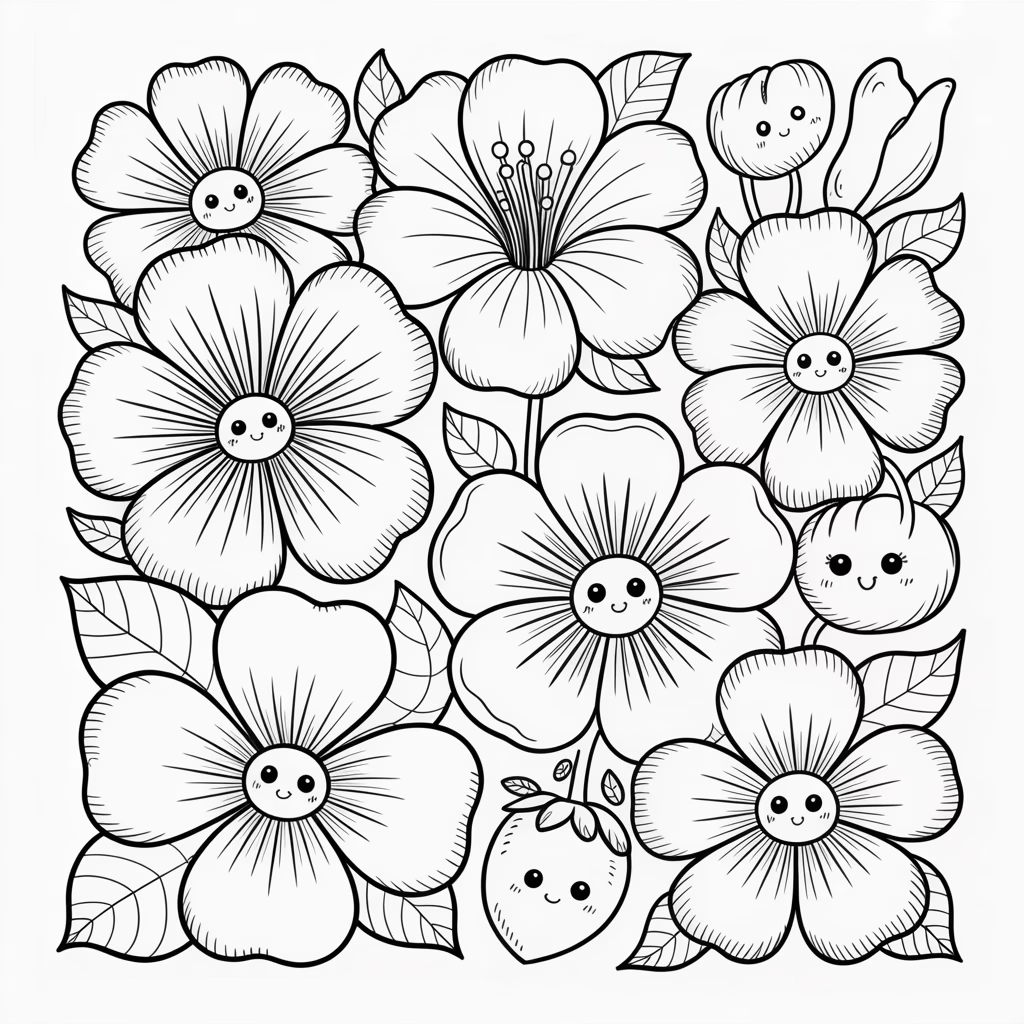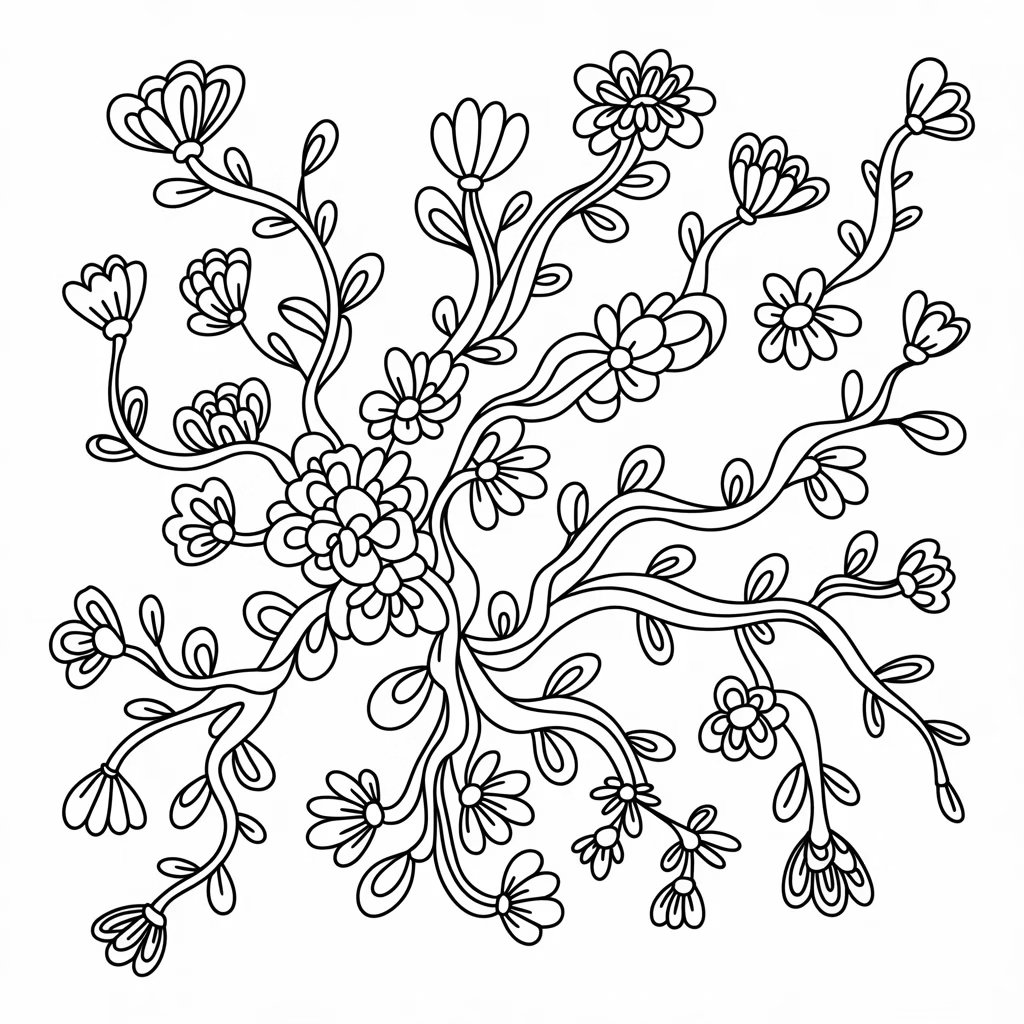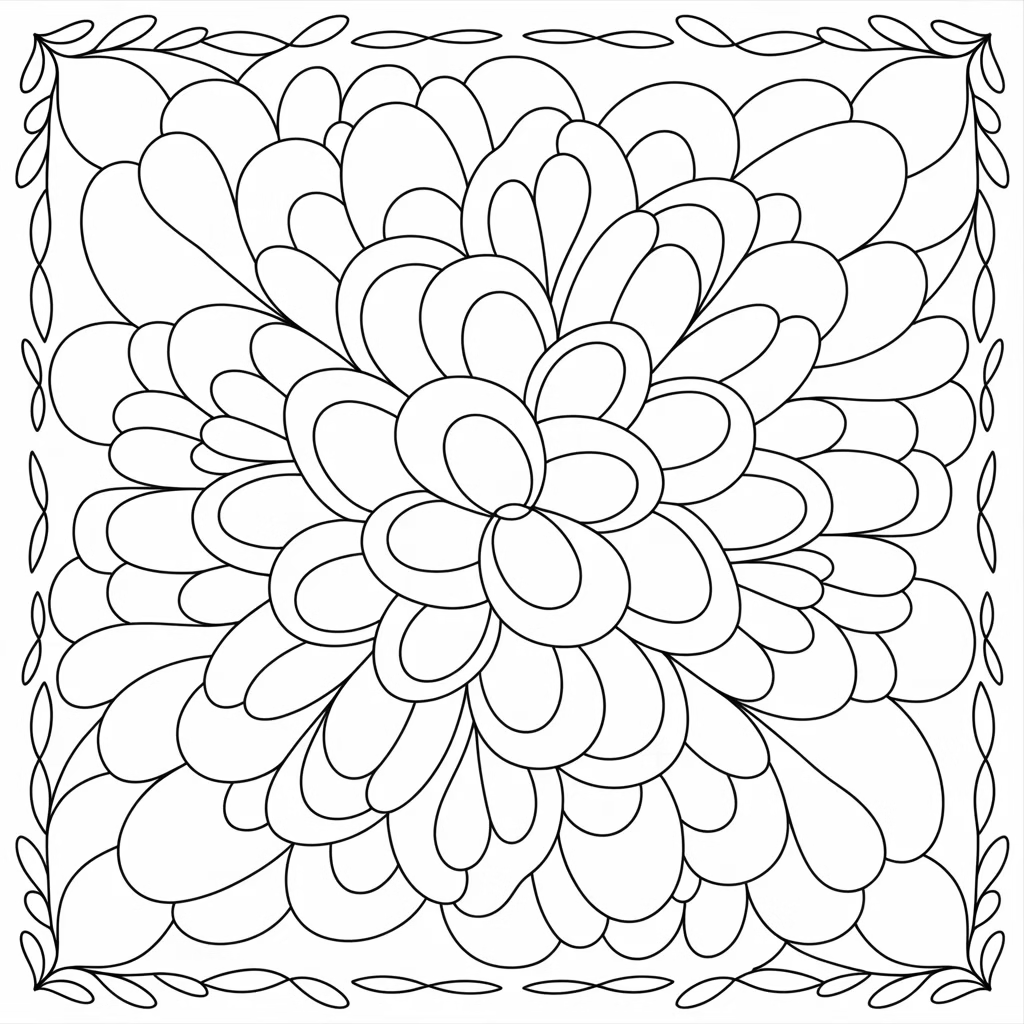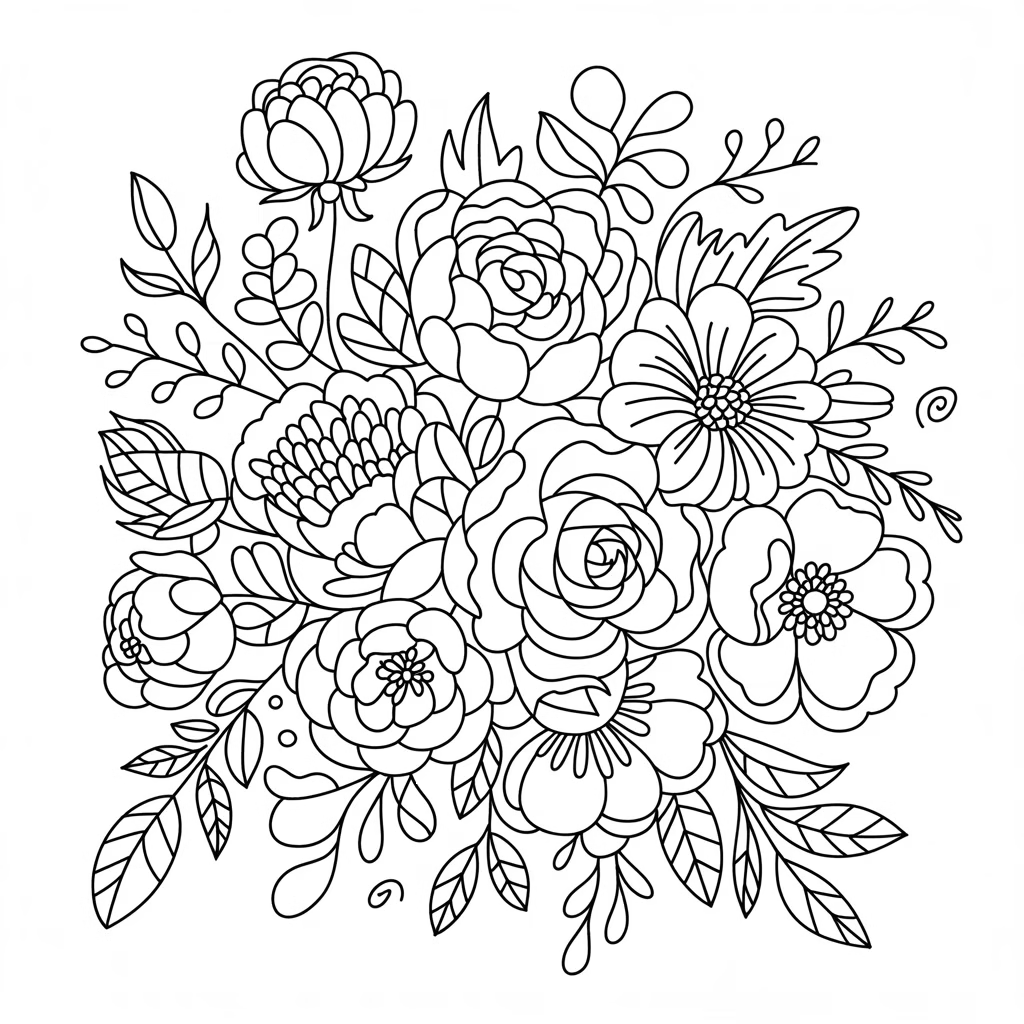Floral doodle art serves as a charming medium for expressing creativity while incorporating elements of nature into your artwork. Regardless of whether you are a novice or a seasoned artist, there exists a plethora of techniques and sources of inspiration to investigate. Begin with straightforward flower doodles, such as roses, tulips, and daisies, utilizing quick tutorials and artistic flower concepts that cater to all skill levels. These uncomplicated pen flower doodles can be created using basic shapes like ovals and circles, with the addition of simple lines or dots to represent the thickness, curvature of petals, or the receptacle of a flower. For those seeking more advanced techniques, consider crafting floral doodle frames and patterns. Start by sketching a frame in pencil, then doodle around it, ensuring that most of your drawings remain behind the frame while incorporating a few elements in front to create depth. Upon completion, outline the remaining parts of the frame with a marker to finalize your design. You may also wish to experiment with various patterns and textures to enhance depth and interest, concentrating on the space surrounding and between the subjects of an image rather than the subjects themselves. To personalize your journaling, notes, and planner, attempt doodling exquisite flower patterns in your bullet journal. These straightforward flower drawing tutorials will enable you to adorn your bujo with flower patterns, inspiring your next creation. Additionally, you can design a floral banner as a header in your journal and embellish it with captivating doodles to infuse personality into your journal pages. For further inspiration, delve into Pinterest, where a vast array of flower doodle ideas awaits, ranging from simple designs to more intricate patterns. With 114 pins dedicated to flower doodles, you are bound to discover something that ignites your creativity. If you aspire to enhance your floral designs and cultivate greater creativity in your floral doodles, consider utilizing books that provide step-by-step guides and innovative ideas. By employing these techniques and sources of inspiration, you will be well on your way to producing stunning floral doodle art that reflects your distinctive style and creativity.
Simple Daisy Doodles
Simple Daisy Doodles offer a charming and whimsical enhancement to your artwork. Regardless of whether you are a novice or a seasoned artist, these straightforward daisies can serve as a fun and imaginative addition to your sketches, journals, or even rock painting endeavors. To craft a simple daisy doodle, begin by sketching a gentle arch for the flower’s center, then proceed to add the outer petals, filling in the spaces between them to form a fully blossomed daisy. You can elevate your daisy doodle by incorporating a few lines within the petals or shading the center for additional detail. For inspiration, consider exploring Pinterest’s extensive array of simple daisy doodle ideas, which display a multitude of creative and distinctive daisy doodle designs. If you seek custom or handmade daisy doodle pieces, Etsy provides a variety of daisy doodles that can infuse a personal touch into your artwork or home decor. Furthermore, you can discover high-quality Daisy Doodle stock images on Shutterstock, which can act as a reference for your own doodle creations. To enhance your daisy doodle skills further, think about watching easy daisy doodle art video drawing tutorials, such as the one shared by myartacademy42 on Instagram. These tutorials can offer step-by-step instructions and valuable tips for producing stunning daisy doodles. With consistent practice and inspiration from diverse sources, you will be able to master the craft of simple daisy doodles and incorporate a touch of floral elegance into your creative projects.
Rose Petal Patterns
Rose Petal Patterns represent a fascinating element of the rose, a flower esteemed for its beauty and fragrance worldwide. Roses, which belong to the genus Rosa, are primarily native to the temperate areas of the Northern Hemisphere and are cultivated as ornamental plants in various climates, including prominent regions such as Ecuador, Colombia, and Kenya. The intricate beauty of rose petals, soft and velvety to the touch, creates patterns that appear to dance in the gentle breeze, enhancing the allure of these flowers. Most rose species exhibit a five-petal arrangement, with exceptions like Rosa omeiensis and Rosa sericea, which typically feature only four petals. These patterns not only enhance the aesthetic appeal of roses but also carry symbolic meanings across different cultures. Roses, especially red ones, symbolize love and passion, while other colors such as pink, yellow, and white express admiration, friendship, and purity, respectively. Cultivating roses to highlight their petal patterns necessitates meticulous care, including proper soil preparation, sufficient sunlight, and regular watering. Pruning is crucial to encourage healthy blooms and manage the plant’s shape, ensuring that the intricate patterns of the petals are showcased to their fullest potential throughout the season. Beyond their ornamental significance, rose petals are employed in various applications, including perfumery, cosmetics, and culinary arts, where they impart a subtle floral essence to products like rose falooda, rose sherbet, and rose milk. Ultimately, the patterns created by rose petals serve as a testament to the enduring beauty and complexity of nature, enriching our lives with their splendor and significance. Whether enhancing gardens, bouquets, or even utilized in creative endeavors such as handmade patterns available on platforms like Etsy, rose petal patterns continue to inspire and enchant with their timeless elegance.
Sunflower Swirls
Sunflower Swirls represent a captivating feature of the sunflower, a plant that enchants with its vivid beauty while also possessing considerable cultural and economic significance. Scientifically referred to as Helianthus annuus, sunflowers are indigenous to the Americas and are renowned for their large, golden-yellow blossoms that appear to swirl and dance in the sunlight. The sunflower’s center, known as the disk, consists of densely packed small flowers that can be brown, yellow, or purple, while the outer ring is made up of ray flowers, which are generally golden yellow. These ray flowers, often confused with petals, are actually ligules formed from fused petals of asymmetrical ray flowers, and they can also manifest in red, orange, or other hues. The swirling design of the sunflower’s disk and ray flowers enhances its visual charm, making it a favored selection for ornamental gardens and a representation of vibrancy and beauty in nature. Sunflowers are appreciated not only for their appearance but also for their practical applications. The leaves can be used as fodder, the flowers produce a yellow dye, and the seeds serve as a source of oil and food, with the oil being regarded as comparable in quality to olive oil. This adaptability highlights the sunflower’s economic significance, especially in areas like Kansas, where it is designated as the state flower and the state is affectionately referred to as the Sunflower State. Growing sunflowers to exhibit their swirls necessitates full sunlight and fertile, well-drained soil enriched with mulch, ensuring that the plants reach their full potential and display their swirling patterns magnificently. The life cycle of a sunflower, from seed to maturity and back to seed, exemplifies nature’s cycle of growth and renewal, with seeds being sown in spring and harvested in the fall. The swirling designs of sunflowers, along with their practical and symbolic importance, render them a treasured element of our natural environment, inspiring everything from poetry to agricultural practices.
Tulip Twists
Tulip Twists represent a fascinating aspect of the tulip, a flower celebrated for its vivid hues and graceful shape. Tulips, which belong to the genus Tulipa, are indigenous to a broad region extending from Southern Europe to Central Asia and have been cultivated for many centuries, symbolizing ideal love and frequently linked to the rejuvenation of spring. The twists found in tulip petals, particularly prominent in varieties such as the ‘Black Parrot’ tulip, contribute a distinctive aesthetic charm, conjuring images of feathered edges that can morph into various animals or mythical beings when observed from different perspectives. These twists not only amplify the visual appeal of tulips but also provoke personal contemplation, reflecting the diverse experiences of life through their array of colors, ranging from bright reds and yellows to deep purples. Cultivating tulips to highlight their twists necessitates meticulous attention to soil quality, sunlight exposure, and watering practices, ensuring that the plants reach their full potential and exhibit their unique petal designs splendidly. Tulips are not only revered for their beauty but also possess considerable cultural and symbolic significance. They are frequently featured in poetry and literature to express themes of love, passion, and the ephemeral nature of existence. For example, in Sylvia Plath’s poem “Tulips,” the vibrant tulips are portrayed as overly lively, disturbing the tranquility of the speaker’s surroundings, symbolizing the encroachment of life’s vibrancy into a state of serenity and introspection. Beyond their decorative appeal, tulips have been honored in various artistic forms and media, from Instagram captions that captivate followers with their allure to poems that delve into the profound meanings behind their beauty. The twists in tulip petals, along with their rich symbolism and cultural importance, render them a treasured element of our natural environment, inspiring everything from personal reflection to artistic creativity.
Lily Loops
Lily Loops represent a captivating and graceful aspect of the lily flower, recognized for their elegant appearance and profound symbolism. Lilies, which belong to the genus Lilium, are renowned for their breathtaking blooms that exhibit a variety of colors, such as white, pink, orange, and yellow. The distinctive looping forms of lily petals evoke a sense of movement and fluidity, rendering them a preferred choice among both artists and gardeners. These loops not only enhance the flower’s visual charm but also symbolize purity, renewal, and transience, often linked to themes of rebirth and new beginnings. When sketching lily loops, artists can concentrate on the unique curves and shapes of the petals, which can be illustrated with soft, flowing lines that reflect their delicate essence. The act of creating lily doodles can be both soothing and fulfilling, allowing for personal expression through the application of color, shading, and intricate designs. By trying out various styles, such as whimsical or realistic portrayals, artists can cultivate their individual methods of capturing the allure of lilies. Beyond their aesthetic appeal, lilies carry cultural importance in numerous traditions. For example, in many societies, they are utilized in religious rituals and festivities, symbolizing purity and devotion. The adaptability of lily loops makes them an excellent subject for a range of artistic endeavors, from greeting cards to home decor. By integrating these graceful shapes into your artwork, you can honor the beauty of nature while exploring your creativity, making lily loops a charming addition to any doodle art collection.
Orchid Outlines
Orchid outlines represent a captivating feature of the orchid family, recognized for their complex shapes and remarkable beauty. Orchids, which belong to the genus Orchidaceae, constitute one of the largest families of flowering plants, with thousands of species distributed worldwide. Their distinctive structures and varied colors render them popular among both artists and gardeners. The delicate outlines of orchid petals can differ greatly among species, displaying a spectrum of forms from the graceful curves of the Phalaenopsis to the elaborate patterns of the Cattleya. When artists create orchid doodles, they can concentrate on the unique shapes and outlines that characterize these flowers. The petals frequently exhibit a graceful, flowing quality, which can be captured through gentle, sweeping lines. By highlighting the loops and curves of the petals, artists can instill a sense of movement and fluidity in their creations. Moreover, adding playful elements, such as adorable faces or whimsical patterns, can transform conventional orchid outlines into delightful, kawaii-inspired artwork. Orchids also carry cultural significance in numerous traditions, symbolizing beauty, strength, and love. They are commonly utilized in floral arrangements for special events, enhancing elegance and sophistication in any environment. The adaptability of orchid outlines makes them an excellent subject for a variety of artistic endeavors, ranging from greeting cards to wall art. By delving into the beauty of orchid outlines, artists can honor the intricate details of nature while expressing their creativity in distinctive and personal manners.
Petal Play
Petal Play offers a charming exploration of the beauty and complexity of flower petals, inviting artists and doodlers to interact with nature’s designs in a fun way. The process of doodling petals provides a means of creative expression that goes beyond conventional drawing methods, encouraging individuals to try out different shapes, sizes, and patterns. Each petal can be reimagined into a distinct design, highlighting the variety present in nature. By concentrating on the gentle curves and vivid details of petals, artists can craft whimsical compositions that inspire joy and amazement. This artistic journey emphasizes the freedom to explore and innovate. Doodling petals can also function as a meditative practice, allowing artists to immerse themselves in the rhythmic flow of their lines. The repetitive act of creating petal patterns can be both soothing and energizing, offering a sense of achievement as each design materializes. Furthermore, adding elements such as cute faces or playful expressions on the petals introduces a kawaii charm, enhancing the artwork’s appeal. Petal Play not only improves artistic abilities but also nurtures a greater appreciation for the natural world. As artists examine the intricate features of real petals, they can translate these insights into their doodles, connecting reality with imagination. Ultimately, this playful exploration of petals promotes creativity, mindfulness, and a celebration of the beauty that flowers contribute to our lives. Whether for personal enjoyment or as part of a broader artistic endeavor, Petal Play serves as a joyful reminder of nature’s wonders.
Leafy Lines
Leafy Lines present a captivating journey into the various shapes and forms of leaves, encouraging artists to interact with nature’s designs in a creative and playful way. Leaves, which are the essential organs of plants, exist in countless shapes, sizes, and textures, each adding to the overall allure of the flora they are part of. Engaging in doodling leafy lines enables artists to explore different styles, ranging from simple outlines to complex patterns, thereby capturing the essence of nature in a whimsical manner. The act of creating leafy doodles can be both soothing and energizing, as artists immerse themselves in the rhythmic flow of their lines. By concentrating on the distinctive features of various leaves—such as the serrated edges of oak leaves or the gentle curves of willow leaves—doodlers can craft a vibrant tapestry of designs that convey a sense of movement and vitality. Incorporating playful elements, such as adorable faces or imaginative patterns, infuses a kawaii charm into the artwork, enhancing its appeal. Leafy Lines not only improve artistic abilities but also cultivate a greater appreciation for the natural world. As artists examine the intricate details of real leaves, they can transform these insights into their doodles, bridging the divide between reality and imagination. Ultimately, this playful exploration of leaves promotes creativity, mindfulness, and a celebration of the beauty that nature provides, making Leafy Lines a delightful enhancement to any artistic pursuit.
Vine Ventures
Vine Ventures represents a creative journey into the intricate beauty and complexity of vines, encouraging artists to interact with nature’s designs in a playful and imaginative way. Vines, recognized for their capacity to climb and intertwine through diverse environments, embody growth, resilience, and connection. Engaging in vine doodling enables artists to explore various shapes, patterns, and styles, capturing the essence of these lively plants in a whimsical manner. The act of creating vine doodles can be both calming and energizing, as artists delve into the fluidity of their lines. By concentrating on the distinctive features of different vines—such as the spiraling tendrils of climbing plants or the delicate leaves that embellish them—doodlers can produce intricate designs that convey a sense of movement and vitality. Adding playful elements, such as charming faces or imaginative patterns, infuses a kawaii appeal into the artwork, enhancing its engagement factor. Vine Ventures not only sharpens artistic abilities but also cultivates a greater appreciation for the natural world. As artists examine the intricate details of actual vines, they can translate these insights into their doodles, bridging the divide between reality and imagination. Ultimately, this playful exploration of vines promotes creativity, mindfulness, and a celebration of the beauty that nature provides. Whether utilized for personal pleasure or as part of a broader artistic endeavor, Vine Ventures acts as a delightful reminder of the marvels of the natural world and the joy found in artistic expression.
Blossom Borders
Blossom Borders are a fun way to dress up the visuals for your doodles and designs with a sprinkle of nature’s magic. These floral edges will wrap around any of your images which makes the perfect photo moment/scene to the center of your background. Artists can build custom borders that mirror their personality and imagination by mixing different flowers, leaves and fantasies. Creating a bloom border helps you to try out different types of blooms, shapes, and placements. An artist is able to select from among a variety of flowers such as daisies, roses and tulips, all of which would lend varying degrees of charm and character to the border. By experimenting with colors, patterns, and lines, doodlers can develop all of the tools needed to express personal creativity while describing nature by framing a scene with the perfect doodled design.Featuring contributions from Corina BeckerLaura-Wright Urquhartand Cory Thurrottthis inspiring collection offers instructions for doodling the components of weather(from rain boots and umbrellas to fog and a rainbow) as well as floral illustrations and animals galore. Blossom borders come with an extra bonus in that they can provide inspiration and increase mindfulness. Drawing buds and leaves impels artists to look with more attention to the world around them. This connection can help us to better appreciate the complex nature of our flora and create a sense of calm and pleasure during the creative process. At the end of the day, Blossom Borders are more than decorations, they are a tribute to the beauty of nature and creativity. Whether you’re putting them in your journal, sending snail mail and grateful thoughts via greeting card, or attaching them to larger-scale projects, these floral frames lend the perfect touch of magic to the art and to the natural world surrounding it.
Stem Studies
Stem Studies is an intriguing examination of the complex world of plants, with a key emphasis on the important role stems have in the development and structure of flowers. Stems form the structural axis of the plant, are supportive and assist in water and nutrient flow between roots and leaves. In the art of doodling, the investigation of stem designs allows for the admiration of beauty among the stems and their relationship with the flowers they house. Artists have the opportunity to play with shapes, lengths, and textures with their doodled stems so they can take on the qualities of different types of plant. For example, the dainty, elegant stems of lilies differ from the thicker, sturdier stems of sunflowers. With the addition of fun details such as sweet faces or quirky patterns, creative types can make their doodles come alive with personality and style, and add screeds of curb appeal to things like greeting cards, and artwork. Stem studies foster mindfulness and observation as well, for it’s only by taking the time to truly see real stems in nature that we may record their essence in artwork. It’s a practice that not only improves art skills, but instills an appreciation for the intricate nature of plant life. When the artist interprets what they see and sketch out a doodle, they connect the real world and imagination, using it as a way to express and perceive the beauty of the nature. In the end, Stem Studies is a celebration of everything that flowers are, and of a reminder of how their parts are all interconnected, encouraging artists to think about how to make blending Stem anyone’s doodling pleasure. Whether used in personal journals, greeting cards, or larger art projects, these studies emphasize the grace and significance of stems in the floral world.
Bud Basics
Bud Basics A fascinating introduction to the world of flower buds Rosemary Wise Take a closer look at the beauty and potential of flower buds. BUDS: Buds are tiny little bumps or miniature lumps, common in nature, which, when they grow and develop they become new life; for example a new leaf, flower or branch. This point of growing is important because it’s the leap from dormancy to life, symbolizing the very backbone of rebirth and nature’s hope. Artists — when you’re drawing the buds of flowers, play with different shapes, versifying shapes and drawing the diverse features of buds from each shrubbery. For example – peonies short, tight closed round buds against the long slim buds on lilies. Bloom Bud Basics surprises and delights readers by transforming common flower buds from the ordinary into the charming and whimsical through playful illustrations buds with cute faces or budding flowers dressed as adorable characters The Bud Basics creative process encourages mindfulness and observation of the world budding around them. agneslepack1-emailToday s artists doodle their flower buds from memory, using their own unique marks to create the adorable full color illustrations featured inside this book about drawing playful flower buds from the basics. Such exercises not only develop the creative skill but will also deepen understanding of the complexity of plant forms. In the process of artistically transforming what they see into doodles, the artists blur the line between what is and what could be, and how artistic expression can marvel at nature in its creativity At its best, Bud Basics is a happy celebration for artists to be reminded of the beauty in what a small unfurling can become–a blank canvas that is ripe for creative exploration and expression! Find Me Flower Buds feature prominently in studies for the larger art piece and make a gorgeous pair used in personal journals or on greeting cards, too Flower Buds are so pretty and important in the world of flowers, too So much of beauty that it brings to you And the next time you see a flower bud, You will appreciate it so with wide eyes stud Measures approximately 6.75” x 8.5” Acid and lignin free Whether you choose to use it in crafting, share a sketch with a friend or keep it all to yourself in a journal or notebook.
Floral Flourishes
Floral Flourishes is a beautiful addition to simple flower doodles that will make any illustrations prettier and more interesting. These ornamental components, whether it is with circular swirling lines, detailed and complex patterns, or dainty details, help bring the work up to the level it is. Incorporating flourishes in floral designs can help convey movement and texture, dance and flow, turning a basic flower into a stunning statement piece! It’s messy and fun to let kids add the flowers. Artists can work in different style from soft, smooth sketches through crossed out, wispy lines and on to energetic, bold swirls and taps and then on to more dense and scratchy styles but always keeping their own voice. This is not only an excellent exercise in developing art skills, but it is also a therapeutic way to connect with nature when we observe the fine details of real flowers and their environment. With this series of scribbles, which are based on their own experiences but sometimes exaggerated beyond reality, they close the chasm between the world as it is and the world as we imagine it, and in their own way, express how beautiful the world is. Not to mention, flower accents can also be used to communicate feelings and motifs. Like soft, curving lines that can suggest calm and supple, or more dynamic flourishes that contribute energy and vibrancy. This wide range of meanings makes floral flourishes an indispensable piece in creating the mood or saying contained within an artwork for artists. In the end Floral Flourishes are a wonderful reminder of the elegant and subtle variety of nature’s beauty in something as simply as a doodle that would inspire the artist to open their creative minds! Whether included in your personal journals, inside a card, or as part of a larger art project, these embellished tendrils of creativity calling cards to draw your gaze toward the fine-art side of floral designing.
Doodle Bouquets
Doodle Bouquets offer an entertaining way of bringing creativity and natural subjects together, enabling artists to create their own floral designs whilst indulging their affection for flowers. These whimsical groupings can easily be achieved by combining different species of flowers with different shapes and features that all compliment each other, to create an interesting bouquet. Doodling flowers allows for lots of variation in styles, colors, and patterns, and a wide variety of results makes it a fun subject to draw. If you want to draw a doodle bouquet, the artist can begin with a simple frame of the bouquet, which can be drawn as circular or oval shape. From there, they can populate it with an array of flowers (including daisies, tulips and roses) that, like their real-life counterparts, come with playful details like adorable little faces and intricate patterns. This cheeky twist not only adds whimsy to the piece, but also gives artists room to express themselves through their favorite flowers and styles. Doodle bouquets can be put to all sorts of lovely uses from decorating personal diaries and planners, to making individual and exclusive greeting cards or even framed for your wall. They are great for getting on the porch or at home getting in some practice and relaxation, so that when you go out you’ll be ready and able to create beautiful artwork. It’s also meditative, she added: Doodling can put artists in a state of flow where they can relax into their work. In the end, Doodle Bouquets are a lively testament to the radiant splendor of flowering flora that encourages artists to draw in an exciting, fresh way and brings a little bit of nature into their creative lives. Regardless of whether they are for you to enjoy, giving the gift of a painting or even displayed as part of an art installation, they are picturesque floral displays that evoke the beauty of nature and the pleasure of painting.
Wildflower Whimsy
Capturing nature at its most magical, Wildflower Whimsy by Peter Gray invites artists to venture into the wild and experience the whimsical beauty of wildflowers as never before. A mix of different shapes, colors and textures, Wildflowers exude freedom and spontaneity, lending themselves well as a theme for more creative designs. Doodling Wildflowers give the nod to everything from the tiniest, most delicate sketch to the loudest, most colorful representations of wildflowers, embracing the individual characteristics of each and making the familiar new again. Drawing to create wildflower doodles fosters a sense of immersion into the natural world as artists get up close and personal with actual wildflowers while they are growing. This facility for looking teaches mindfulness, the ability to be present to the beauty and wonder on every side even while making art that embodies that awareness. Through the use of elements such as kawaii faces or silly patterns, an artists’ wildflower doodles can be filled with personality and charm, taking an average flower and giving it a personality all it’s own. You can use Wildflower Whimsy for a lot of things, including spicing up personal journals and planners, making one-of-a-kind greeting cards or even wall art. Wildflowers are happy and free-spirited, This is why people like looking at them because they smile and feel like kids again. Also, since the repetitive action of doodling is much the same as meditation, is has a soothing and anti-stress effect- it’s the perfect way to unwind during a busy day or even in the middle of a mind-racking one. In short, Wildflower Whimsy is a tribute to all that’s lovely and varied in nature and a call to colorful arms for artists everywhere to let out their wild side. Whether assembled for their own entertainment, or a piece in a bigger art project, the little floral designs are a way for lovers of both the natural world, and creativity to delight in both.
Garden Glyphs
Gardens become magical places that nature uses as its blank canvas, and every tree, flower and plant tells a story. The idea of “garden glyphs” may then fit as the symbolic shape to the variety of objects that grow in these green refuges. Each and every one, whether it be of a flowering blossom, thick tree or twisting vine, perfectly captures the feeling of life and the bond between the living things in an ecosystem. In a garden these signs manifest themselves in the beauty of the seasons and in the close interactions of plant life with the environment. Walking through a garden, enjoying the bright colours in the flowers and the soothing buzzing of bees, can have a similar grounding yet at the same time refreshing effect. The thoughtful placement of plants is like a painting, where all elements contribute to the harmony of the whole. Garden glyphs don’t just represent the plants themselves, but the feelings they inspire — joy, peace, a sense of being part of the natural world. In addition, gardens are important ecosystems that support a wide variety of species, thus aiding biodiversity and environmental stability. They are centers of education and discovery where people can experience the natural world, hone their gardening skills and marvel at the beauty of life in all of its manifestations. On a deeper level garden glyphs keep us aware of the influence that nature has on our lives and we become caretakers of the earth, because in the end it is our that nourishes us.
Flower Mandalas
Flower mandalas are a beautiful combination of two of the most enthralling designs: floral motifs and mandalas. These flower designs can manifest in many ways, sometimes with a flower in the middle of the rug with petals around it and sometimes with an ensemble of flowers where each petal is roughly equidistant from the next. Each flower in a mandala has its meaning, symbolizing things like love, growth and connectivity. For example, a lotus flower mandala represents enlightenment and personal development, while a daffodil mandala represents hope and positivity. Making flower mandalas can be healing, creative, self expressive and a way for people to engage with the natural world. Typically, artists rely on actual flowers, digital designs, or stylized illustrations to create these lovely pictures. Flower mandalas are found in many different formats, from coloring books to tattoos, and they are a popular source of inspiration and soothing for many. Flower mandalas, in addition to their visual appeal, are used as objects of meditation. They also bring clarity to the mind and induce a state of inner peace, making them very useful for growth and spirituality. They allow other people to engage with them and think about their meaning, what they can personally represent, and reflect on their own lives and how they fit into the natural system. After all, flower mandalas are more than just pretty designs; they remind us of life and growth and the interconnectedness we share with nature.
Petal Portraits
Petal portraits are a charming way to express your appreciation of the fragile beauty of the blossoms and buds with elaborate patterns and elaborate pictures. These piece often isolate unique properties of individual petals, featuring textures, colours and shapes that reveal the beauty of flowers in nature. As a focal point, the petal can be studied in reliefs and with the nuances of light and shadow that will lend a luminous quality to a painting, allowing the viewer to be pulled into the world of flora. The method behind these petal portraits are generally a mash-up of traditional meets modern materials; e.g. watercolor, ink, and digital illustration. Artists might render both the bare petals and blooms in their ephemeral glory. This method also highlights the beauty of flowers and transforms it into a reminder of fleeting moments in nature, often overlooked. And then, of course, petal portraits can make people feel all sorts of ways – peaceful, nostalgic, reflective, thoughts of childhood or prior moments spent with nature, etc. Close up so fine and colours so vivid they can take you away and into a peaceful garden or sunlit meadow inviting tranquillity and awareness of our natural world. At the end of the day, petal portraits are not only fine art portraits, they are a celebration of life, of growth, and of the beautiful complexity found in even the smallest of flowers in nature. These portraits draw viewers in, asking us to stop, look and appreciate the small miracles of life.
Blossom Branches
Bloom branche Blowing in the wind is one of natures delicate works of art with the soft and fragile petals running down a rigid branch in contrasting colours. These blooming twigs — whether cherry, apple or magnolia — turn landscapes into living poetry every spring, their petals fluttering like whispered secrets against the sky. The branches themselves are canvases, gnarled twists and smooth bends each framing a cluster of blooms, which range from snow-white to vibrant pink. This dance of strength and softness mimics life’s own juxtaposition: resilience beneath beauty, endurance beneath ephemerality. Blossom branches are more than just a beautiful sight, they also have deep cultural significance. In hanami, they symbolize renewal and the ephemeral nature of life, whereas in western culture, they often symbolize hope and rebirth. Their short-lived bloom — often only a few days at most — encourages us to stop in our tracks for nature’s ephemeral wonders. When indoors, a single blossom branch can make the indoors a sanctuary and bring us back to the outside, both through their scent and form. For artists and writers, these branches are an endless inspiration. Their curves beg for ink strokes; their cups cry out for watercolor washes. Even after the blossoms have fallen, the naked branches are quietly elegant, hinting at another cycle of growth. Deep within a blossom, we find life’s beginning: the most beautiful and fragile saturation of the bloom and the ultimate embodiment of a new life pulsating with the promise of potential and possibility.
Petal Patterns
Petal patterns are a beautiful journey through nature’s design and shows the delicate and complex shapes in the world of flowers. Every petal, unique in shape and texture, forms a tapestry that symbolizes the beauty and depth of life. You can see these patterns in any number of flowers, from the dainty symmetry of a rose to the showy, saturated adornments of tropical flowers. The petal pattern is not only a functional strategy to attract pollinators but it is a visual banquet to ensnare the human eye. Petal patterns often inspire artists and designers, who use the shapes for anything from fabric and wallpaper to artistic creations. The repeat and symmetry in these patterns can create a sense of peace and order, ideal for calming spaces. Petal motifs may also represent change and transformation seen in nature, for example by the blooming and wilting of flowers— which is characteristic of their blossoms and the cycle of life. Furthermore, studying petal patterns can increase our understanding of the biodiversity around us. Every flower species has its own shaped and coloured petals each having developed to suit its own situation, nature is so clever. When we observe and begin to understand these patterns, we can create a stronger relationship with the natural world and thus the importance of protecting these amazing ecosystems. For sure, petal designs are more than just designs; they are a dedication to life, artistry and the complex network of relations in the world around us.
Doodle Bouquets
What do a doodle and a bouquet have in common. Combine one with the other and… you get doodle bouquets. These delightful birds are often seen amongst flowers, leaves and stems in a playful, freeform style that invites fantasy. Unlike most conventional flower designs, doodle bouquets encourage spontaneity, and encourage artists to play with shapes, patterns and sizes without the limitations of reality. However much you may have potted already, and in whichever fancy shapes you choose to juggle them, each one will – in swirly petals, or abstractly – take a delightfully new visual form. One of the defining pleasures of doodle bouquets is just how accessible they are — anybody can grab a pen and make their own version, and many have designed them as part of art therapy and relaxation rituals. Aid for free-form thinking and good old-fashioned doodling, meditation and self-expression. And as people fill their pages with these imaginary floral designs, they take pleasure in doing so, rejoicing in the beauty of imperfection. You can also refer to the Doodle Bouquets for other inspiration – for anything from greeting cards to home decor. They are also highly customizable to fit any theme, whether you are throwing a springtime bash or having a playful wedding invitation. These fun designs can also be employed in digital art to add flair to your social media posts and personal blogs. At the end of the day, doodle bouquets remind us that art can be fun and meaningful, as well as how doodles can help us engage with nature and our creativity in a playful way.
